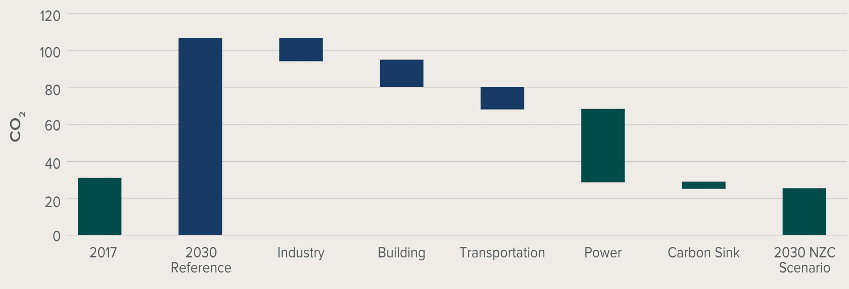
Implementing Life Cycle Carbon Emissions Standards in Urban Development
The construction and operation of buildings account for nearly 40 percent of global CO2 emissions. As the urgency of the climate challenge increases, efforts to address carbon emissions in the buildings and construction sector is shifting from a focus almost exclusively on operations to the full life cycle of buildings. The carbon lock-in from decisions about building materials and recycling potential at the end of life is critical to meeting climate goals. In response, new building life-cycle carbon emissions regulations are emerging worldwide, but there are few real cases of implementation.
The Meishan Near-Zero Carbon Zone new development, located in Ningbo, Zhejiang Province, China, presents a unique leading example of a carbon emissions standard for the full life-cycle of a building with clear targets and a whole process management mechanism. Insights from the Meishan carbon emissions standard can help shape the future direction of low-carbon development for the global construction industry.
The Current Status of Building Life-cycle Carbon Emissions
The buildings and construction sector is a major driver of urban energy use. Building construction—including the manufacturing of materials and products such as steel, cement, and glass—accounts for 6 percent of final energy use and 11 percent of global carbon emissions. And once constructed, buildings are responsible for 30 percent of global final energy use and 28 percent of global carbon emissions. These indicators reflect the necessity to reduce both the “operational” and “embodied” carbon emissions of buildings.
Regulations and policies play an important role in reducing energy use and carbon emissions of the buildings and construction sector. However, the regulations and policies to decarbonize buildings are mainly focused on operational carbon emissions, leaving the embodied carbon as a significant unaddressed issue. A majority of existing energy consumption and carbon emissions-related standards in the buildings and construction sector do not cover the materials, construction, demolition, and recycling of buildings, which all generate significant carbon emissions.
The lack of such standards in the building industry is mainly due to the fact that carbon emissions in the production of building materials have been categorized as industrial emissions rather than building emissions. It is essential that standards be developed and implemented to address the full life cycle of buildings.
Building Life-cycle Carbon Emissions Regulations
Building life-cycle carbon emissions standards help meet emissions reduction targets by quantifying the life-cycle carbon emissions of a building—the carbon emissions generated from the five phases of a building: 1) materials production and transportation, 2) construction, 3) operation, 4) demolition, and 5) waste recycling and disposal.
The standards have two different approaches: 1) using absolute values to restrict the life-cycle carbon emissions of unit building area (kgCO2/m2); and 2) using relative values that measure the carbon emissions reduction proportion of an actual building based on its building emissions benchmark.
Establishing building life-cycle carbon emissions standards could help raise awareness of carbon emissions in the buildings sector, guiding the market to evaluate carbon intensity as one of the major considerations when selecting solutions and products throughout all phases of a building’s life. As a result, the standards also influence building-related industries, such as steel, cement, glass, and appliances, to provide low-carbon products to their customers.
Examples from Around the World
France launched its E+C- scheme in November 2016, a voluntary labeling system and experimentation for new construction, which includes both the energy performance criterion and the environmental performance criterion. Environmental performance is determined by a life-cycle assessment (LCA) of the building from its construction to the end of its life. In particular, the carbon performance of a building takes into account the energy use in operation as well as the embodied carbon in the construction products and equipment. Based on the E+C- scheme, France is preparing a new regulation in 2020 to reduce the overall carbon footprint of new buildings.
In the United States, California started implementing the Buy Clean California Act in July 2019. The act requires manufacturers of four construction materials—structural steel, carbon steel rebar, flat glass, and mineral wool board insulation—to submit Environmental Product Declarations (EPDs) as part of their bid for public work projects. EPDs are public disclosures of potential environmental impacts of products, including a building LCA. California is leading the rest of the country in beginning to account for the carbon footprint of building materials.
China launched the national Standard for Building Carbon Emission Calculation in December 2019, providing standardized calculation methods and carbon emissions factors for a building’s LCA. The standard is a reference to the calculation of carbon emissions during the production and transportation of materials, construction, operation, and demolition phases of new, expanded, and renovated civil buildings. Although this is only a standard for calculation methods, it lays a solid foundation for formulating specific building life-cycle carbon emissions indicator standards.
Leading Practices of Building LCA Standards in Meishan
At the local level, the Meishan Near-Zero Carbon Zone has taken the lead on integrating building LCA standards into its green building plan. The Meishan project is the core functional area of a broader comprehensive experimental zone within the “port-industry-city” development area in Ningbo, China. The zone is set to triple the permanent population and expand the economy fourfold by 2030, while meeting a near-zero carbon target by reducing emissions 70 percent compared to what is expected under the business-as-usual scenario.
RMI has been a key partner supporting the strategic planning of the Meishan Near-Zero Carbon Zone, making quantitative targets and developing techno-economic roadmaps. As shown in Figure 1, to achieve this target by 2030, four sectors will work together by adopting low-carbon technologies and market innovation.
Figure 1. Meishan Carbon Emissions Reduction Contributions by Sectors
For the buildings sector, Meishan will electrify all building energy end-use applications, except cooking, and significantly improve overall building energy efficiency by 40 percent. To achieve the overall 74 percent carbon reduction target in the buildings sector, RMI is working with Meishan to design and implement an LCA standard to set up quantitative targets for carbon reduction. The implementation requires the whole process management system to promote green building materials and products, scale-up energy-efficient building designs, recycle construction wastes, and facilitate new building industrialization.
The best time for launching building LCA standards is at the beginning of the new district planning. Meishan incorporates building LCA standards in the green and low-carbon building plan, which requires a new building’s LCA carbon reduction rate based on a reference building as an obligatory target. Meishan is taking an innovative pathway toward near-zero carbon building, extending a green and low-carbon development concept from the operation phase to the whole life span of planning, design, construction, operation and management, and demolition. Meanwhile, the policy promotes low-carbon ideas to the industry value chain of the buildings sector, pushing suppliers to provide green products.
To implement the building LCA standard efficiently, RMI is working with Meishan to establish a life-cycle management mechanism. As figure 2 shows, through cross-department collaboration of the government, the management covers nine key points in a building’s life cycle. In these key points, project contractors submit LCA indicators and get approval from corresponding government departments. The management mechanism supports the near-zero carbon target strongly and efficiently. The near-zero carbon development plan aims to develop Meishan as a world-class green and modern coastal city to attract international high-end talents and high-tech corporations.
Figure 2. Whole-process management mechanism for near-zero carbon buildings
The building life-cycle carbon emissions standard and management mechanism in Meishan has significant impacts on the building and construction industry, leveraging great carbon reduction potential in a full life cycle of a building, and further incentivizing the whole building industry to be competitive in the market. From the perspective of long-term development, Meishan represents the future direction of low-carbon development and serves as an excellent example for other cities. RMI will continue to support implementation and will share our insights with other cities so that the Meishan case can inform best practices in China and around the world. Through our efforts, we expect more cities will unlock the opportunities to decarbonize the full life cycle of buildings, to realize the deep emissions reduction of the building and construction sector, and to achieve the global strategic goal of tackling climate change.




